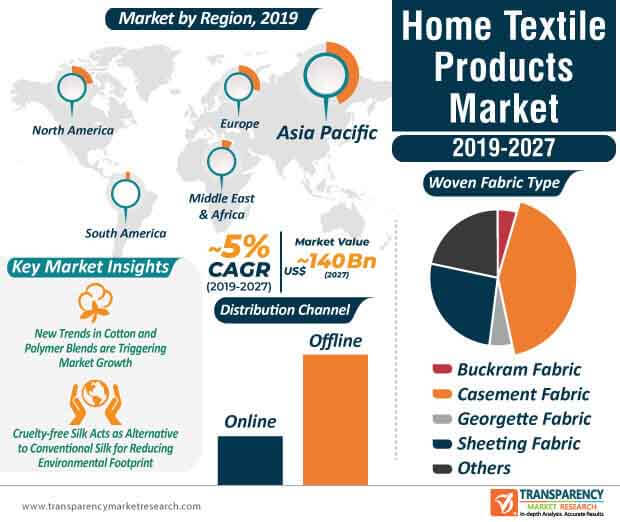
3D Fabrics Gain Popularity Due to Superior Insulation Characteristics
Innovations in 3D cotton textiles are bringing about a change in the home textile products market. Manufacturers are increasing research in human psychology, material characteristics, and its environmental effects to develop innovative products. Since wool provides excellent thermal insulation, companies are developing new materials such as the ‘hollow cotton yarn’ by blending cotton with polymer. Thus, fluffiness, softness, and superior insulation characteristics of hollow cotton yarn are being highly publicized in the market for home textile products.
Fabric construction is another innovative concept, which is gaining importance in the home textile products market. Manufacturers are increasing efforts to develop 3D fabric structures by joining two facing fabrics with a spacer filament. Such innovations are triggering market growth whilst the market for home textile products is estimated to reach an output of ~4,000 million units by the end of 2027. Novel 3D fabrics are acquiring popularity for its superior insulation characteristics.
Planning to lay down future strategy? Perfect your plan with our report sample here https://www.transparencymarketresearch.com/sample/sample.php?flag=S&rep_id=32537

Companies Focus on Achieving Sustainable Production Practices
Circular economy and sustainability are key focus points that are revolutionizing the home textile products market. Stakeholders are increasing efforts to present smart material innovations that cater to responsible innovations in yarn. For instance, Asahi Kasei-a Japan-based chemicals company, is focusing on the development of smart fiber made from cotton linter that does not deplete forest resources. Commitment of stakeholders toward responsible innovation has helped manufacturers in the market for home textile products to bolster their credibility in the global landscape.
On the other hand, regenerated cellulose fiber is gaining prominence in the market for home textile products. This novel fiber derived from cotton is being highly marketed for its fully circular attributes. The Introduction of entirely biodegradable and ecotoxicity-free yarns are key drivers contributing to market growth. Companies are setting their collaboration wheels in motion to combine precious raw materials with distinctive features. They are increasing their production capacities to manufacture new linen blends that are giving rise to breathable and soft fabrics.
Sustainable Silks Grab Attention of Fabric Innovators for Development of Lightweight Products
Consumers are growing increasingly aware about vegan silk, since conventional silk is one of the most polluting material in the market for home textile products. Thus, cruelty-free silk is grabbing the attention of eco-conscious consumers. Other innovative silk materials such as soy silk, spider silk, and art silk are creating incremental opportunities for manufacturers in the home textile products market. The growing number of home apparel brands are embracing sustainable silks that has led to fast growth of the home textile products market, which is estimated to reach a revenue of ~US$ 140 Bn by the end of 2027. Thus, manufacturers in the market for home textile products are increasing research in biodegradable materials to gain competitive edge in the market landscape.
On the other hand, fabric innovators are increasing their efficacy in silk made from orange peels. Thus, its lightweight and versatile qualities are grabbing the attention of individuals that are willing to incorporate home products made from innovative materials.
Looking for exclusive market insights from business experts? Buy Now Report here https://www.transparencymarketresearch.com/checkout.php?rep_id=32537<ype=S
Industry 4.0 and Opportunities in Europe Drive Market Growth
Rapid growth of industry 4.0 and the need for more sustainable manufacturing methods are some of the key drivers contributing to the growth of the home textile products market. Advanced sensor technologies are enabling stakeholders to access comprehensive technical machine data to achieve sustainable production goals. For instance, the Bierbaum Group-a well-known Irisette bedding brand is celebrating its 125th anniversary this year by introducing products that are German Government’s new Grüner Knopf textile seal approved.
On the other hand, companies in the home textile products market are tapping into opportunities with synthetic leathers for the development of innovative home surfaces. This is evident since synthetic material segment is estimated to account for a significant share of the home textile products market. The home textiles sector is anticipated to gain strong business grounds in Germany. As such, this market in Europe is estimated to generate second-highest revenue.





